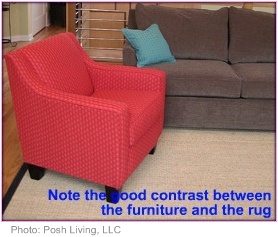Home Decorating Help
Guidelines for Sight and Hearing Impaired Decor
This home decorating help aims to assist you in making décor changes that will enhance the quality of life for hearing or sight impaired family members. With these points in mind you will be well equipped to design any room that will be used by a vision or hearing impaired person.
Home decorating help for the hearing impaired
Most aids for those with poor hearing work by either making a very loud noise or vibrating. The addition of flashing lights to a device helps to grab the person’s attention. Your home decorating plans will be minimally affected, since it is just a matter of swapping a standard device for an enhanced one. There are vibrating and flashing wake-up alarms that can be set up near the person’s pillow. Similar devices that work with flashing lights, or by vibrating, include smoke detectors and doorbells. There are also hearing impaired telephones which ring louder then a standard phone. Some mobile phones are able to work together with special hearing aids so that phone calls are heard much more clearly.

Home decorating help for the sight impaired
People who are sight impaired, or have low vision have either impaired central vision or otherwise have a form of “tunnel vision”. Those with missing central vision have difficulty seeing detail and need high contrast environments with low glare. Those with missing peripheral vision can’t see objects at the outer edges and risk tripping over, or knocking into, items such as low side tables.
Here is some home decorating help - things to include in your home decorating to make life easier for a person with low vision.
Reduce glare:
Glare can be described as harsh or debilitating light reflections that make it difficult to see and perform tasks where vision is necessary.
1. Make sure that lighting is uniform throughout a room. When one source of lighting is much brighter than surroundings it causes glare. When planning the lighting aspect of your decorating, don’t rely solely on one overhead light. Choose table- and floor lamps to brighten up dark corners.
2. Remember that sunlight reflecting off surfaces causes glare as well. Plan your window treatments so that light is more diffuse. A simple voile curtain will not obscure the view at all but will help to soften the light. If you have direct sunlight shining into the room you may find you need something extra to block those harsh rays. Consider using Roman blinds that you can let down half-way; or Venetian blinds or shutters that can be angled to change the lighting in the room. If you are on a tight budget, Roman blinds have the added benefit of being easy to make.
3. Don’t forget task lighting. People with low vision benefit immensely from task lighting that is at the correct angle. Provide extra lighting for reading, writing, cooking, applying makeup etc. Ensure that task lighting does not shine onto reflective surfaces like shiny white paper, or a TV screen, because that will make glare worse. Under-mounted cabinet lighting in the kitchen is more helpful than just an overhead light for two reasons. Firstly the counters are well illuminated; and secondly, an overhead light might cause shadows to be cast over the counter where the person is standing because they are being illuminated from behind.
4. If you are remodelling, try stay away from surfaces that are shiny and reflective - high gloss tiles, stainless steel, and mirrored surfaces.
Continue reading more about interior decorating help for the sight impaired
Return from Home Decorating Help to Interior Design Tips for Disabilites
Return from Home Decorating Help to Interior Decorating Together
|